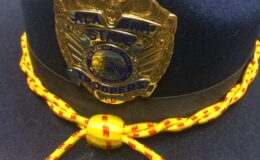

Genealogy is being used to solve crimes (Photo: MGN)
Some of America’s biggest cold cases that have been left open and unsolved for years are now being solved thanks to a growing popularity in websites like “23 and Me” and “Ancestry DNA.”
The science used to identify your ancestral background is also being used to hunt down criminals.
Law enforcement was holding a press conference to announce the closure in a case that had haunted the state, and the country, for decades in late April of 2018.
The FBI had arrested Joseph DeAngelo, a man they believed to be the “Golden State Killer,” a serial killer responsible for over a dozen murders and over 50 rapes in California during the 1970’s-80’s.
The case had gone cold for decades, law enforcement had DNA of the suspect, but no name to match it.
As time progressed, law enforcement tried something different, a newer tool that you wouldn’t really associate with solving crimes.
The DNA craze through websites like Ancestry.com or 23 and Me has now given investigators an additional way to track down suspects through what’s called genetic genealogy.
“It’s a big game changer,” Thea Baker, a professional genetic genealogist, said.
Genetic genealogy uses DNA to find genetic connections between people.
It differs from normal DNA testing from law enforcement because regularly search mitochondrial DNA, which utilizes a person’s maternal family line.
Genetic genealogy uses autosomal DNA, which looks at DNA matches with cousins and other people outside of the maternal line.
“That cell and the genetic material in it carries the map back to our ancestors,” Baker said.
She’s been doing some form of genetic genealogy for years here in Arkansas and has helped connect the dots to her family tree and the trees of people across the country.
“I’ve had some phenomenal finds with genetic genealogy,” Baker said.
It’s all done through websites like GedMatch.
This public DNA database was instrumental in helping law enforcement find DeAngelo back in California.
The genomic data on GedMatch gives genealogists access to a massive amount of information.
Information that also affected an over 30-year cold case here in the Natural State.
In October, law enforcement used DNA phenotyping and ancestral websites to connect Edward Renegar, with the 1990 murder of Pamela Felkins in Faulkner County.
There have been roughly a dozen cold cases solved across the country because of genetic genealogy.
It’s given places like the state crime lab an additional tool in its belt.
“It’s a great technology,” Kermit Channell, executive director of the Arkansas State Crime Lab, said. “You have to know when to use it and if it qualifies for that type analysis.”
Genetic genealogy, Channell said, not only helps solve these cold cases, but also helps identify remains.
“We can generate DNA profiles or an external company can that can be searched against a lot of these genealogy companies that have databases like 23 and Me and so forth,” he said.
If it can’t be done in house, the crime lab generally turns to the University of North Texas, who has a center specializing in identifying remains.
While he doesn’t see the crime lab implementing a full time genetic genealogy position, he says using a genealogist gives an even better chance to close cases.
“All leads have been exhausted well this is another tool that might be able to help identify the perpetrator of a crime,” Channell said.
Crimes similar to the ones of the Golden State Killer.
Thanks to genetic genealogy, that arrest concluded a high-profile investigation
As technology and popularity increase, both Channell and Baker say investigations that have reached dead ends will see resolutions because of this practice.
“You’re going to be able to see this utilized more and more on unsolved cases,” Channell said.
“You know, the pendulum of time only swings in one direction,” said Baker. “It’s not going to go back on this because it works.”
Now one of the main issues that comes with sharing your DNA is privacy.
For example, if you have a 5th cousin, whom you’ve never met, commits a crime and you decide to make your DNA public, part of the DNA you share with that 5th cousin will be public without him ever knowing.
That being said, you have to give permission to make your DNA public.
Channel 7 asked Baker about this and she doesn’t see a problem because not only does it take a massive amount of time to sift through this data, but if you commit a crime, you’re going to have a wanted poster out for you, whether it’s a physical poster or a piece of your DNA.












